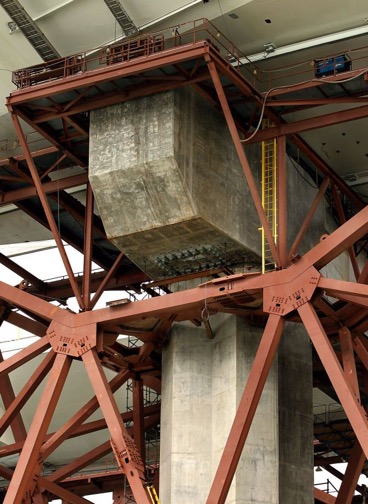The Onging Saga Of The New Bay Bridge Eastern Span Or How Corpoate Greed, Corruption, and Corporate Government Deregulation Demonstrate The Decline Of The U.S. Empire
Expert: Over 600 Bay Bridge rods too hard Bay Bridge parts may be susceptible to cracking

The new eastern span of the Bay Bridge was begun in January 29, 2002, with initial cost estimate was $2.6 billion. It was first scheduled to be completed in 2007. Now with a total cost estimate of $6.4 billion (and counting) there is there is still no actual completion date in sight.
The new Bay Bridge eastern span has more than 1,200 bolts made from galvanized steel that is virtually identical to a high strength alloy that a nationwide group of transportation officials banned for bridge use because it can crack over time, The San Francisco Chronicle has learned:
…Forget about the fasteners in the sets testing standards for fasteners, said Caltrans had ‘juryrigged around the standard to fit their needs.’… He called the state’s actions ‘irresponsible’. ‘If they were trying to skirt” hardness limits for bolts and rods, he said, ‘that’s fraud’. He said his committee never expected that a bridge builder would do what Caltrans did, use galvanized A354 rods like banned galvanized A490 bolts. ‘Those of us in industry know better than to do that’, he said. ‘Since it’s not supposed to have been made, we didn’t think of forcing the tests for that”. . . . Vertullo said industry standards specify that any galvanized fastener made hard enough to be susceptible to embrittlement must be tested for the problem before being installed. Caltrans says no such tests were conducted. ‘I don’t know whether they knew about the rule, it certainly looks like they didn’t follow it’, Vertullo said. He added that the way Caltrans handled the selection and testing of fasteners used on the bridge was not in line with good practice. ‘You have to use proven, nonexperimental technology when you are building a bridge’, Vertullo said. ‘You have an absolutely critical component — I would have to say if the standard was thoroughly read and understood, (Caltrans) would not have done this.’ . . . Russell Kane, a corrosion engineer who has served on American Society for Testing and Materials committees, said the panel that set the A490 bolt standard “came down on the side of ‘thou shalt not galvanize’,‘while the group setting rules for A354 fasteners ‘is putting the onus on the user to decide whether or not galvanizing is going to be acceptable.’ . . . ‘In this case, Caltrans made the leap,’ Kane said. ‘What we don’t know is whether they looked before they leaped. Did they investigate? Or did they just make a blind leap?’ UC Berkeley engineering Professor Bob Bea, who has studied the failure of high-strength steel, said Caltrans was asking for trouble by loading up the eastern span with galvanized hardened fasteners. ‘Steel is like people,’ Bea said. ‘Some people are really ductile and resilient. You can stretch them, tweak them, and they keep on ticking. Some of them, you scratch them and they bleed to death.’ ‘Hard steel’, he said, is the materials equivalent of a human hemophiliac. ‘You end up with structural hemophilia. You scratch it, it bleeds and falls down dead.’ — Experts question Bay Bridge steel rods Galvanized metal may be too hard, at risk of cracking
China Builds 26.4 Mile Long Bridge For Just $1 Billion More Than the Cost of The 1/2 Mile New Bay Bridge Eastern Span!
China builds world’s longest bridge
